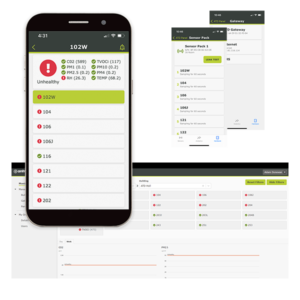SVL News
Coffee Break with Jared Lee from Antrum
How does Antrum improve on Demand-Controlled Ventilation?
We asked Jared Lee from Antrum to explain their system during our most recent Coffee Break webinar. In these 45-minute sessions, we invite the brightest minds in HVAC to discuss the newest technologies and ideas. Ask your SVL Sales Engineer for an invite.
A DCV Refresher
Demand-controlled ventilation (DCV) is a system that achieves the “automatic reduction of outdoor air intake…when the actual occupancy of spaces served by the system is less than occupancy.” This is often achieved by mounting CO2 sensors in various spaces in a building or the unit return.
As CO2 levels increase/decrease, the number of people in the space can also be assumed to have increased/reduced. In response to these readings, the BAS can modulate the outdoor air damper or VAV boxes to deliver more/less air to a space.
Sensor Drift
In most VAV applications, like schools with a CO2 and RH sensor in each classroom, a DCV system relies on individual zone-level readings. Each sensor needs to be maintained and calibrated to work effectively. ASHRAE 62.1 states that sensors should be calibrated or replaced every five years.
This maintenance is often disregarded because calibration can be complicated, replacing sensors is expensive, and with sensors still delivering data to the BMS, it doesn’t look or feel like anything is broken.
But every sensor will drift if not maintained, leading to unreliable data and missed energy-saving opportunities.
AntrumX for Better BMS Data
The apparent weakness in a DCV system is maintaining a fleet of sensors scattered across a building. To solve this, AntrumX offers a “centralized monitoring” solution to track the IAQ of up to 32 spaces from a single location with zero moving parts.
Instead of taking air readings in the spaces, the AntrumX system pulls air samples from every zone back to a central panel that independently monitors each airstream for different VOCs. A series of plenum-rated ¼-inch tubing connects the main panel to the building zones — the terminus is a faceplate with a small hole. The air is drawn back to the central panel using vacuum pressure.
What can AntrumX monitor?
 In short, AntrumX is designed to monitor whatever airflow contaminants you choose. A standard package of sensors might track CO2, particulate matter (PM1.0, PM2.5, PM10), TVOCs, dew point and RH.
In short, AntrumX is designed to monitor whatever airflow contaminants you choose. A standard package of sensors might track CO2, particulate matter (PM1.0, PM2.5, PM10), TVOCs, dew point and RH.
But the system is customizable and scalable for when your IAQ monitoring needs change. You can add refrigerant sensors (R410A, R32, R454B) which could help detect the location of refrigeration leaks in an extensive loop. Methane sensors might be required in public buildings near fracking operations. Ozone detection can be used for wildfire preparedness.
The benefit of the AntrumX infrastructure is that when the codes or requirements change, you need only replace the sensor package in the central panel (about a one-minute procedure) instead of having to replace the individual sensors in every room in the building.
And because AntrumX eliminates the possibility of sensor drift, you can be assured your BMS is receiving the most accurate occupancy data possible, resulting in maximized opportunities for your VAV system to deliver optimal energy savings.









































